When building a house, it is important to choose a material that can combine in yourself as ...
|
|
Aerated concrete blocks are quite popular, so it allows you to build buildings ... |
Loops of accessories, which several years ago was unremarkable ... |
Arbolit with your own hands
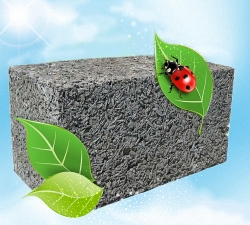
Monolithic arbolite is one of the most economical building materials used for more than 50 years in different countries for low -rise buildings. Economical construction made of opilcoo concrete, as it is called, respectively, will be in demand at all times, especially when erecting secondary pieces of industrial workshops or for private suburban housing construction. In the monolithic walls, the arbolite mass is poured into the prepared formwork, and for the traditional construction of the house, a mixture of concrete and sawdust is formed in the form of blocks.
Table of contents:
- Properties and composition of arbolite
- What is part of the arbolite
- The main properties of blocks
- Arbolite production
- Formal of blocks from arbolite
Properties and composition of arbolite
The advantage of the material is minimal cost, low thermal conductivity, simplicity of manufacturing technology and arbolite composition. Brick blocks from a mixture of sawdust and concrete with some impurities are available and reliable, it is easy to make them with their own hands directly in the summer cottage, which will give additional savings. Its minimal thermal conductivity makes it in demand even in cold climate. It is not difficult to make forms for filling the prepared mixture independently, taking into account the required sizes, and if necessary, the material lends itself well to sawing.
Like foam concrete, opilco concrete is classified as building materials from a group of light concrete. It is somewhat similar to an artificial stone, made on the basis of woodworking waste, this chips, small chips and sawdust. Arbolit photos of a variety of use of material in construction.
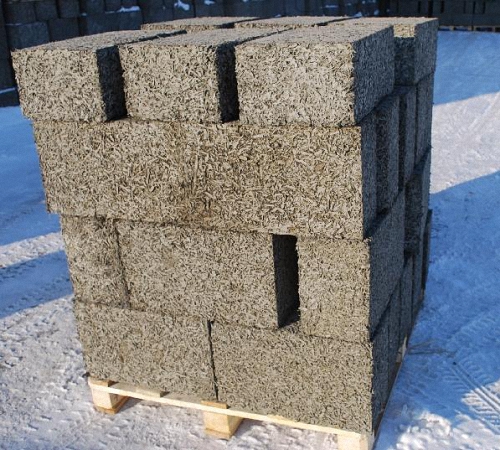
Today, arbolite is formed in the form of plates, blocks, panels and monolithic walls. The standard release of the material of the material external blocks 20x30x50 cm and small panels, and the partitions and pieces are made from blocks of 20x20x50 cm. For thermal insulation, the finished panels of 120x230x20 (28) cm are most often used. At the same time, this standard is recommended, but not mandatory, manufacturers often pour out arbolite blocks other sizes. The diameter and shape of the internal voids, as well as the composition of the material, also varies. According to GOST, the arbolite blocks have an internal coating with a concrete-lime solution that prevents moisture.
Depending on the climatic zone and natural conditions, other dry plant components are often added to sawdust. Similar technologies for the manufacture of brick have been known since antiquity, but the mixture of straw and clay most widely used, and today experimenters to create economical building materials are emphasized by concrete mixtures with industrial production waste.
In the post -war period, during the period of active Soviet construction, the supporting blocks found widespread use due to accessibility and economy. In addition to the monolithic arbolite, the wood mixture with concrete was poured in the form of hollow bricks. At the same time, arbolite the dimensions can have both standard and arbitrary, it is important that they are convenient for styling.
Abroad, analogues similar to the domestic building materials are popular:
- woodstone,
- dyuripanel,
- durizol and others.
Today, arbolite is used for the construction:
- prostenkov in the construction of industrial buildings;
- garages;
- house -building;
- country houses;
- storage facilities;
- summer cottages;
- typical cottage construction.

In houses of small number of storeys, arbolite is used to build not only internal walls, but also external, requiring facing decoration, for example, siding or wild stone. Carrying walls and secondary pieces are cast from the arbolite, they also make light structures for fences or partitions from small hollow blocks. In addition, in the cold climatic zone, it is successfully used for an additional second layer when warming the external stone walls, that is, as thermal insulation - arbolite video.
The density of heat-insulating and structural blocks in the range of 400-850 kg/cubic meter.
Thermal conductivity of the arbolite is 0.08 W/M-0.17 W/m, that is, higher than that of foam concrete, expanded clay concrete and all types of brick.
The frost resistance of building materials F25-F50, as an experiment, was used in Arctic and Antarctic construction.
Fire resistance indicators 0.75 h-1.5 hours, does not ignite.
In terms of resistance to damage to rodents, termites, bacteria, fungi and rot, the classification of bio resistance V group V.
What is part of the arbolite
Arbolite is blocks consisting of a two -component mixture filler from wood waste and light concrete with a small number of chemical stabilizers for wood resistance. Despite the wood base, suburban houses are no different in strength, sound and thermal insulation from more expensive materials. The only requirement is mandatory.
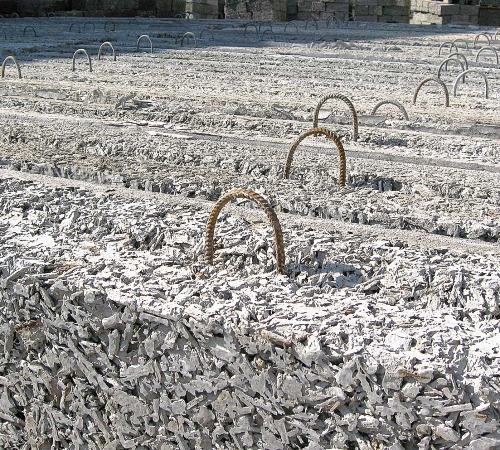
The material is fire resistant, does not give shrinkage, conditionally has 2 varieties of structural (more dense, full -bodied) for external walls and heat -insulating with voids for internal work and upper floors. Light blocks are successfully used to facilitate the upper floors in small buildings on soils, where they do not recommend erecting large and high private houses.
The basis of the composition of the arbolite:
- sulfate or Portland cement;
- wood-organic filler;
- chemical additives.
Chemical stabilizers are able to give the wood of arbolite additional properties:
- remove excess polysaccharides from cellulose for the durability of the material;
- significantly increase bactericidal indicators;
- adjust the porosity of sawdust, etc.
Dry waste processing is used under the filler:
- chips,
- shavings,
- sawdust,
- crushed bark and needles,
- solid stems of agricultural crops (cotton, cereals, rice straw, etc.), depending on local raw materials.
Thanks to this technology, in order to save money, building materials from improvised plant waste can be made in remote agricultural regions. Do -it -yourself arbolite release can be established in series for local needs.
There are other options, respectively, the technology blocks of arbolite blocks, for example, sometimes use liquid glass with ash, lime, sand, slag and other components.
The main properties of blocks
The properties and technology of arbolite combine the advantages of concrete and natural eco -materials for construction. For example, concrete gives him strength, and a tendency to self -ventilation, heat retention and the absorption of smells from wood. Like all building materials, arbolite has its cons and obvious advantages.
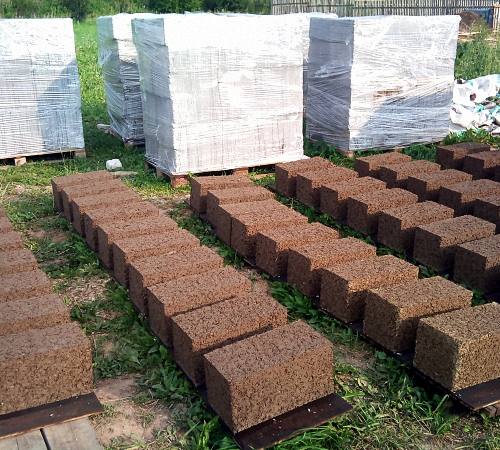
1. The main advantages of building materials:
- multifunctionality in construction the ability to cast monolithic walls, blocks, plates, jumpers for window and doorways of the required shape and size;
- arbolite lends itself to processing (sawing and drilling), makes it possible to obtain blocks of the desired configuration, for example, triangular, under the alignment of a number of a sharp -hearted roof;
- economical building material from improvised ingredients;
- the simplest production technology and the ability to manufacture blocks directly at the construction site;
- the hardened arbolite has high adhesion, is well lend itself to cladding and decoration, often without a frame and a reinforcing grid;
- due to the high thermal insulation, the houses from the arbolite are characterized by lower heating costs than stone analogues;
- arbolite is fire resistant, despite the wood contents;
- not subject to rot and damage to the fungus;
- frost -resistant material;
- high soundproofing, it is favorable for use in the construction of houses near the railway and airfields;
- the ease of material makes it indispensable on problem soils;
- environmentally friendly arbolite is appreciated by allergy sufferers and supporters of eco-construction technologies;
- homogeneous material with an equal distribution of the mixture;
- gives the least of all waste when sawing, and broken blocks are easy to glue with mounting glue;
- it gives time saving when laying, thanks to large and light blocks;
- has a small specific gravity;
- does not give shrinkage;
- perfectly holds fasteners (screws, nails, dowels) and light fittings for decorative decoration.
2. Arbolite has its disadvantages:
- it requires the construction of a high concrete foundation for building a country house with waterproofing if a country area is erected in places of high humidity. This is due to the porosity of the material, and it is very difficult to get out, it is very difficult to get out, because the arbolite is distinguished by a large water absorption of up to 50-80%. Due to low moisture resistance, the protective decoration of the outer layer is required;
- ready -made blocks can not always be bought, and it is sometimes problematic to make arbolite with your own hands. In many places, this simple and well -forgotten technology is only revived. Arbolit with your own hands Video gives a complete picture of the technology of production, which should be carefully studied before engaged in its manufacture on your own.
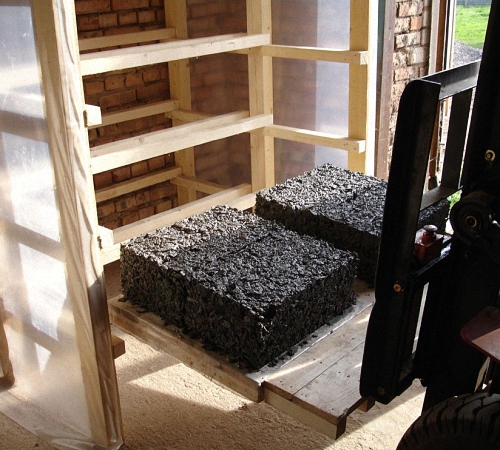
Arbolite production
The arbolite mixture for forming blocks is prepared differently, depending on the technology. For example, based on a concrete mixer, liquid glass, wood chips, and Portland cement of the brand 500.
To produce large volumes of arbolite, special equipment can be rented or purchased. To do this, you will need equipment for:
- kneading,
- ramers,
- press-form masonry,
- drying stoves,
- a place for hardening, protected from moisture.
Specialized companies that sell them together with a set of equipment have detailed technologies for industrial production of arbolite blocks. In domestic use, you can use the simplest recipes, the method of grinding woodworking waste and arbolite technology, however, you can’t do without concrete mixers and forms for obtaining blocks.
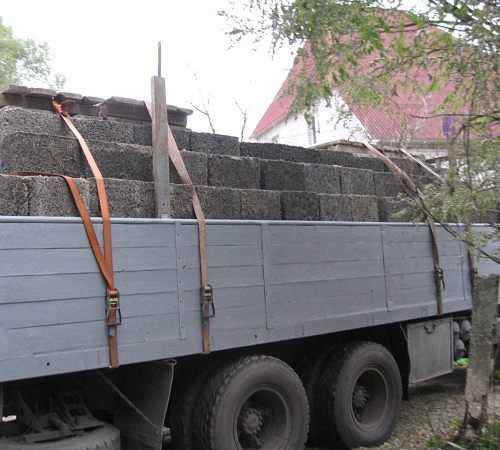
Formal of blocks from arbolite
The best filler for the mass for arbolite will be diverse sawdust in mixtures with chopped chips treated with lime solution, which have already passed exposure (drying) for 3-4 months in the air. Sawdles moistened in lime solution are mixed and dried, it will remove cellulose polysaccharides to eliminate the causes of decay and swelling.
The shape for rectangular blocks can have arbitrary dimensions, but it is better to use the standard 25x25x50 cm. The boards inside should be as smooth as possible. Pieces of film linoleum can be additionally treated with KN-3 mastic.
Experienced craftsmen recommend making forms for arbolite blocks from scraps of boards with their own hands, and for the convenience of seizure of finished products, they are advised to fill pieces of linoleum on the walls. The mixture during the filling of the form can be seized manually by any suitable device for this. If there is a ready -made vibration press, you can use it.
The filled block is kept a day inside the form, after which it is laid out under a canopy for hardening. Some technologies recommend withstanding blocks under the film for the final hydration of 1.5-2 weeks. The low temperature of the warehouse does not affect the quality of the arbolite blocks, but they should not be left in the cold. In the heat, blocks can dry out and crack, so they are periodically sprayed with water.
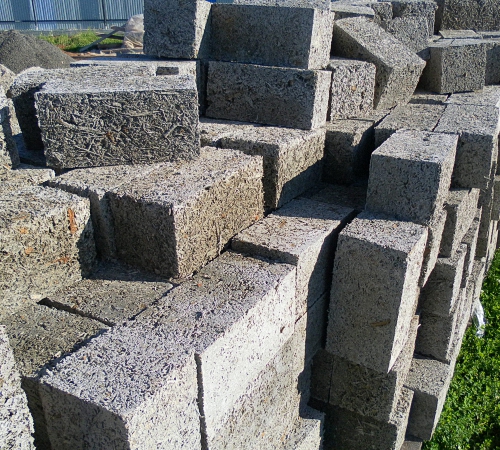
It is convenient to knead the opilcic concrete mass in a metal trough or a box where sifted sawdust and chopped chips are laid out, pour water with chemical boards with a solution of water. The moistened substrate is well mixed until smooth, then poured with cement, mix and add dry cement again until a thick consistency is obtained. The most convenient mixing is obtained in a small concrete mixer.
Tested proportion:
- 1 part of the volume of the sawdust plus chopped chips,
- 1 part of the volume of dry cement,
- 1.5 parts of water with additives up to 4-5%.
There can be more cement, while the arbolite will be stronger, but heavier, and for the porous and hollow material, which goes to insulation and beds, cement is added less.
For additives, it is used:
- liquid glass;
- calcium chloride;
- aluminum or aluminum sulfate;
- slaked lime.
When filling the form with a mixture for obtaining a arbolite, you can insert 2-3 identical wooden throws to obtain voids. The mass is laid in layers in 3 doses with subsequent sealing with any suitable device such as a bit or a wooden hammer. For arbolite, you can add reinforcement between the layers to the first floor. The excess is necessarily removed, the top is aligned, for example, with a wide building spatula, the shape is set under a canopy for solidification of concrete.
When extracting a finished arbolite block, we turn the form on an even platform and hardened material is exposed for a week under the film and finally dries 3-8 days before the masonry.
The first batch is better to make a small one to verify the properties of the received arbolite. You can experience the possibility of sawing, perforating and holding nails.
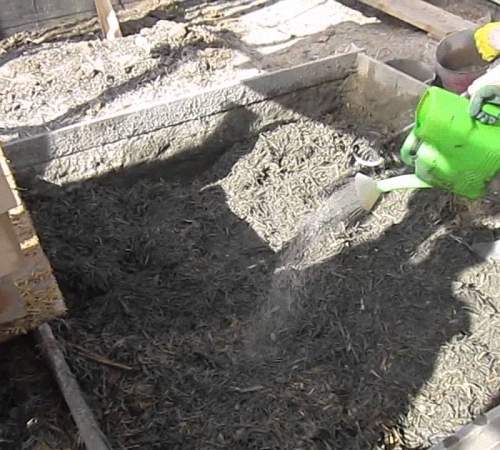
Tips: the more heterogeneous chopper mixture, the stronger the arbolite comes out, the chips and chips provide additional internally reinforcement. Organics are crushed in a crusher. Laundice processing makes sawdust more suitable as building materials. Also, before filling the form, it is treated with lime milk inside. It is impossible to build from a freshly prepared arbolite!
The surviving arbolite is ready to build the blocks conveniently lay, cut or chop, if necessary, they are processed with any cutting tool. A textured plaster for external work and any finishing materials without the need to use the primer can be applied on top of the wall of the arbolite.

How is 1 part of the sawdust and 1
How is it 1 part of the sawdust and 1 part of the cement? Do you need a cement cube cube for a cube of sawdust? !